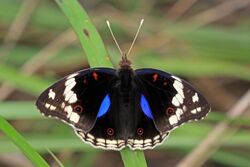Biology:Junonia oenone
| Junonia oenone | |
|---|---|

| |
| J. o. oenone, Queen Elizabeth National Park, Uganda | |
| Scientific classification | |
| Domain: | Eukaryota |
| Kingdom: | Animalia |
| Phylum: | Arthropoda |
| Class: | Insecta |
| Order: | Lepidoptera |
| Family: | Nymphalidae |
| Genus: | Junonia |
| Species: | J. oenone
|
| Binomial name | |
| Junonia oenone | |
| Synonyms | |
| |
Junonia oenone, the blue pansy or dark blue pansy, is a Nymphalid butterfly native to Africa.[2][3] "Blue pansy" is also used in India to describe Junonia orithya.[1]
Subspecies
- Junonia oenone oenone from continental Africa.[1]
- Junonia oenone epiclelia Boisduval, 1833 from Madagascar , Aldabra, Astove, Assumption and Cosmoledo Island.[1]
J. o. epiclelia male, Madagascar
J. o. epiclelia female, Madagascar
Description
The wingspan is 40–52 mm.[4] The upper surface of the forewings is black with white markings towards the apex. The upper surface of the hindwings is black with white markings on the outer edge, and a characteristic large metallic-blue spot. This blue spot is smaller and more a dull purple in females.[3] The underside of the forewings is brown with white markings corresponding to those on the upper surface. The under surface of the hindwings is almost uniform brown.
Larval food plants
The larvae feed on Adhatoda densiflora,[3] Mackaya bella, Justicia natalensis and Asystasia (A. gangetica[3]), Isoglossa, Pualowilhelmia and Ruella species.[4][5]
References
- ↑ 1.0 1.1 1.2 1.3 "Junonia Hübner, [1819]" at Markku Savela's Lepidoptera and Some Other Life Forms
- ↑ South African Butterfly Conservation Assessment: http://sabca.adu.org.za/, retrieved 28 July 2010.
- ↑ 3.0 3.1 3.2 3.3 Williams, M. (1994). Butterflies of Southern Africa; A Field Guide. ISBN:1-86812-516-5.
- ↑ 4.0 4.1 Woodhall, Steve (2005). Field Guide to Butterflies of South Africa. Cape Town, South Africa: Struik. ISBN 978-1-86872-724-7.
- ↑ Larsen, Torben B. (1996). The Butterflies of Kenya and Their Natural History.
- Junonia oenone, UK Butterflies
Wikidata ☰ Q2717039 entry
 |




